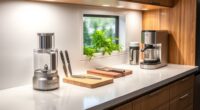To design a minimalist kitchen that lasts, focus on high-quality materials and functional design. Choose durable appliances and timeless elements like wood and metal. Prioritize organization by utilizing smart storage solutions and embracing open shelving to keep things accessible. Maintain a neutral color palette for a calming environment, and regularly edit your kitchen items to avoid clutter. With these principles in mind, you’ll create a serene cooking space that truly enhances your culinary experience—there’s more to explore.
Key Takeaways
- Prioritize high-quality, durable materials like natural wood and metal to ensure longevity and sustainability in your minimalist kitchen design.
- Utilize smart storage solutions such as drawer organizers and hidden storage to maintain a clutter-free environment while maximizing functionality.
- Embrace open shelving to display essential items, creating an airy feel while reducing dust accumulation and maintaining visual simplicity.
- Opt for a cohesive color palette with neutral tones to promote a calming atmosphere and ensure a timeless aesthetic in your kitchen.
- Regularly assess and declutter kitchen items every six months to maintain efficiency and a minimalist approach to your space.
Assessing Your Kitchen Needs
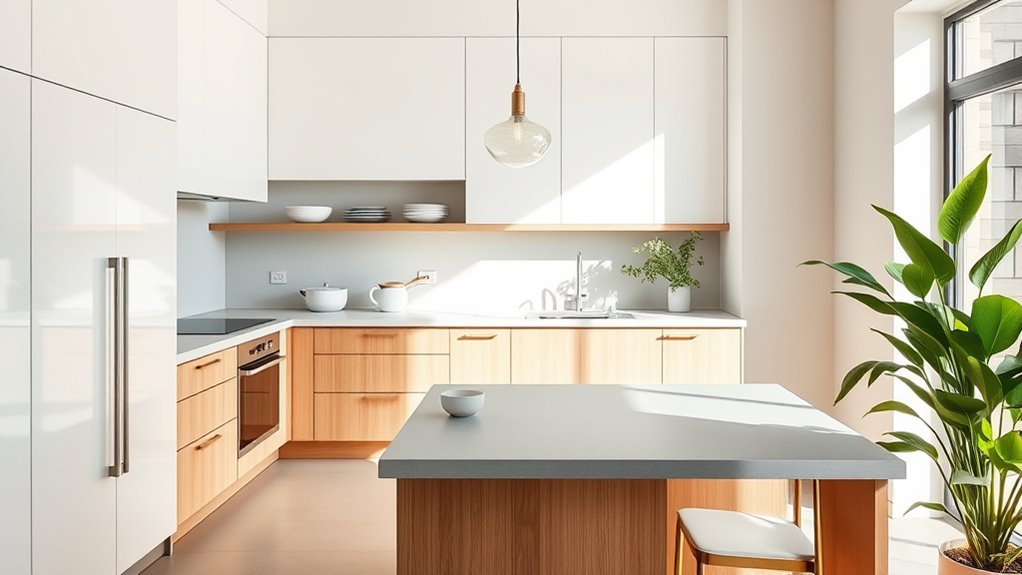
When designing a minimalist kitchen, it’s crucial to evaluate your specific needs. Start by reviewing your kitchen items; identify which tools and appliances you’ve actually used in the past year. This helps you pinpoint what’s vital for your cooking habits, especially in a small kitchen where space is limited.
Prioritize versatile, high-quality kitchenware that can serve multiple functions, reducing clutter from specialized gadgets. Evaluate your storage capabilities to keep necessary items easily accessible, while minimizing excess clutter.
Regularly revisit your kitchen collection, removing anything you haven’t used in the last six months. This ongoing process of evaluating your kitchen needs will guarantee your space remains functional and organized, allowing you to enjoy a streamlined cooking experience. Additionally, regularly assessing your kitchen items can help prevent clutter buildup and ensure efficiency in your cooking space.
Choosing High-Quality Materials
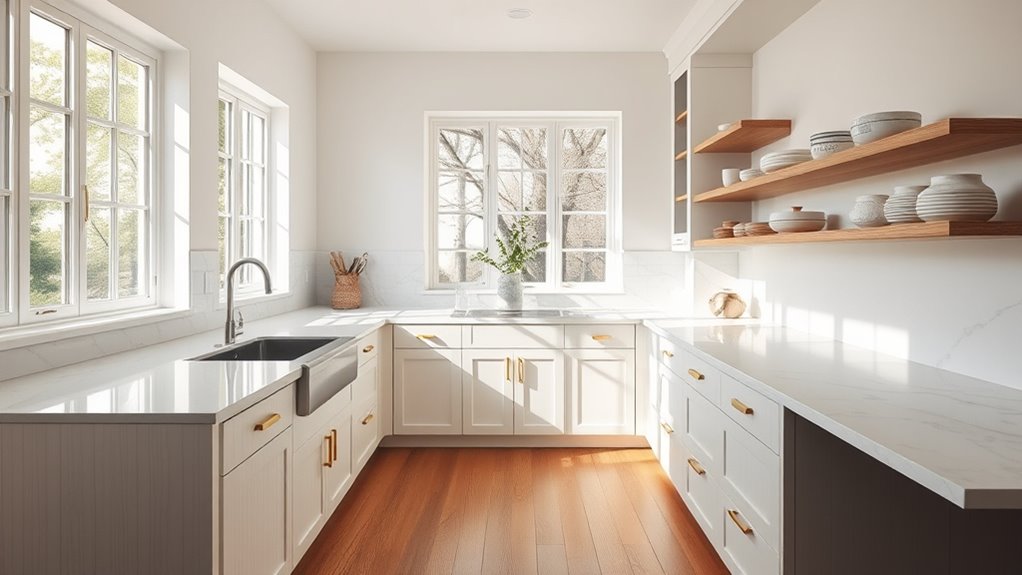
When choosing materials for your minimalist kitchen, think about sustainability and timeless design. Opting for durable options like natural wood or stone not only enhances your kitchen’s aesthetic but also guarantees it stands the test of time. Additionally, using eco-friendly materials can contribute to improved energy efficiency in your home.
Sustainable Material Selection
Choosing high-quality materials is essential for creating a sustainable minimalist kitchen, as it guarantees longevity and reduces the need for frequent replacements.
When you focus on sustainable material selection, opt for natural stone, solid wood, and durable metals. These materials not only stand the test of time but also promote eco-friendliness.
Incorporating reclaimed or recycled elements adds unique character while minimizing environmental impact. Don’t forget to choose low-VOC finishes and paints to enhance indoor air quality.
Prioritize timeless aesthetics, like marble or oak, to make certain your kitchen remains appealing for years. Investing in high-quality fixtures and energy-efficient appliances also supports long-term sustainability, reducing energy consumption and waste in your minimalist kitchen. Additionally, ensure compliance with local fire safety codes when installing kitchen appliances that may pose fire risks.
Timeless Design Choices
To create a minimalist kitchen that stands the test of time, it’s essential to focus on timeless design choices rooted in high-quality materials. Selecting materials like solid wood, marble, and durable metals guarantees longevity and a sophisticated aesthetic.
Authentic options, such as Douglas fir and volcanic stone, provide warmth and character while enduring functionality. Emphasizing textural contrasts, like polished marble countertops with rough-hewn wood cabinets, adds visual interest without cluttering your space.
Investing in high-quality finishes, such as matte lacquer or textured slates, enhances the design and minimizes replacements, promoting sustainability. Finally, incorporating timeless colors like neutral tones allows you to adapt to changing trends while maintaining a foundational minimalist aesthetic that never goes out of style.
Prioritizing Functional Design
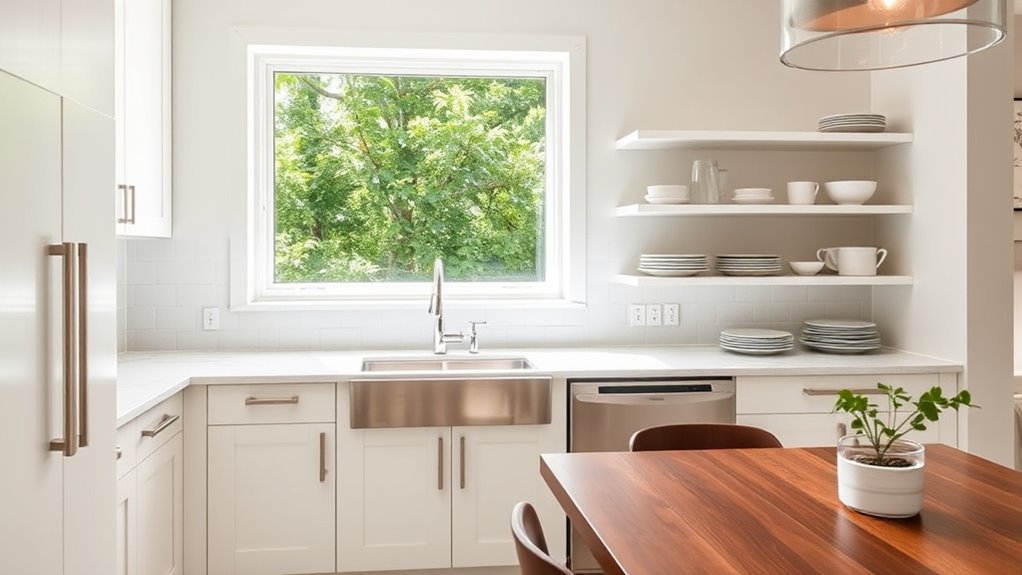
While designing a minimalist kitchen, focusing on functional design is key to creating an efficient space.
Start by prioritizing essential kitchen tools and small appliances, keeping only those you use frequently. This guarantees versatility and reduces clutter.
Incorporate storage solutions like gadget garages and larder cupboards to maintain a tidy environment, making frequently used items easily accessible.
Design your countertops with minimal items, limiting them to daily-use essentials for a clean workspace that promotes efficient cooking.
Utilize open shelving to display only everyday items, which helps reduce dust and enhances visual simplicity.
Finally, choose durable, high-quality materials that withstand daily use, assuring your kitchen remains practical and visually appealing over time. Additionally, ensure good lighting design to create a welcoming atmosphere in your cooking space.
Implementing Smart Storage Solutions
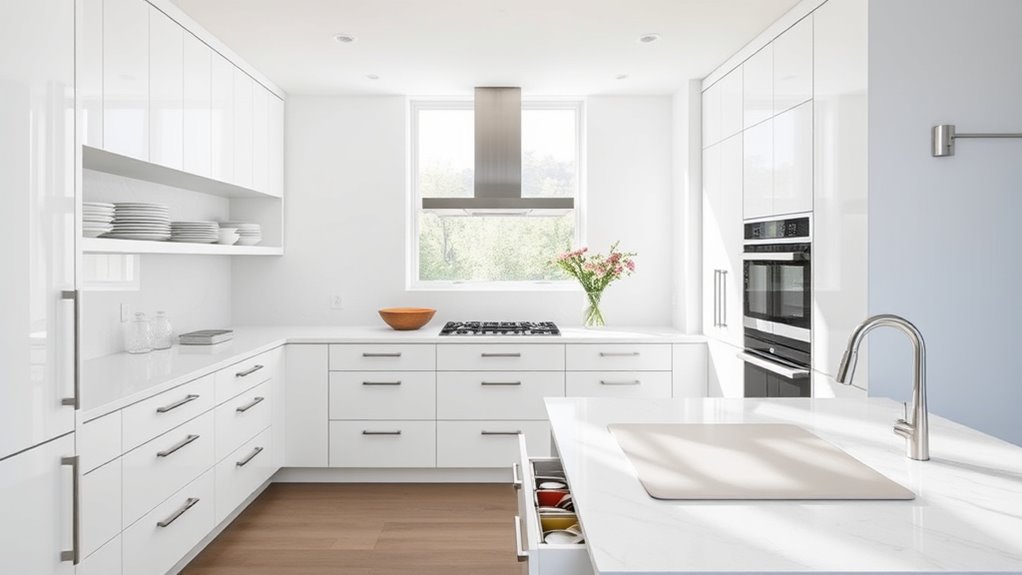
Implementing smart storage solutions not only maximizes space but also keeps your minimalist kitchen organized and functional.
Consider incorporating hidden storage options like gadget garages or larder cupboards to maintain a clutter-free environment while keeping essential items easily accessible.
Use storage containers to group similar items, making it simple to find what you need without creating visual chaos.
Drawer organizers and dividers can help you efficiently arrange utensils, cutlery, and tools for quick access.
Additionally, design with plug molds hidden underneath cabinetry, ensuring your countertops remain clean and appliances are still user-friendly.
Opt for multi-functional furniture or appliances to reduce the number of individual items, further optimizing your kitchen’s layout while enhancing its overall efficiency.
Embracing Open Shelving
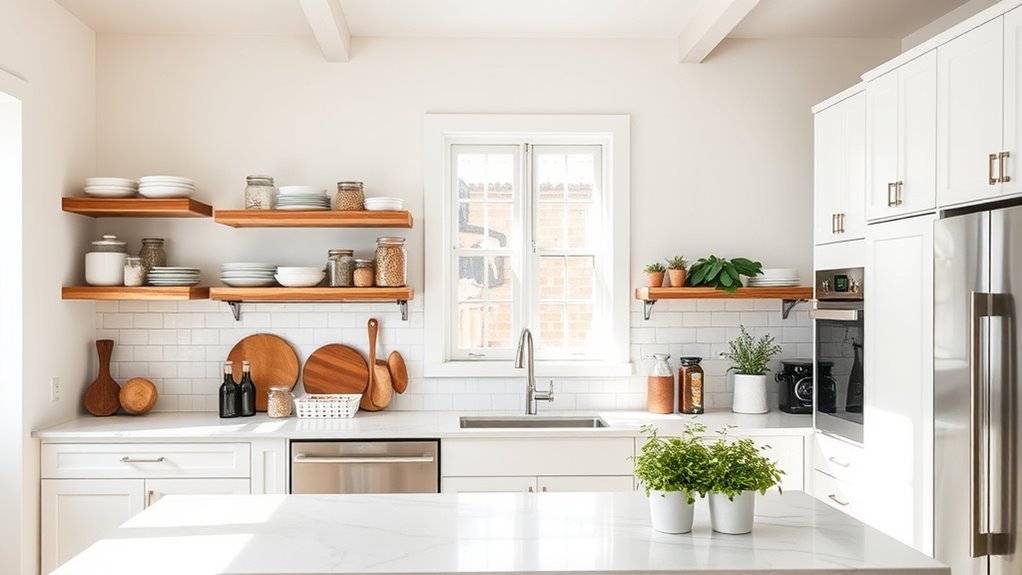
Open shelving can transform your minimalist kitchen by showcasing your everyday essentials while keeping the space airy and inviting.
To make the most of this style, focus on displaying only items you use regularly and love, ensuring order and simplicity.
With a few thoughtful styling tips, you can highlight both functionality and aesthetic appeal in your kitchen.
Benefits of Open Shelving
Embracing open shelving in your minimalist kitchen can transform the space into a stylish and functional area. Open shelving creates an airy feel, allowing easy access to frequently used items while minimizing visual clutter. By displaying everyday items, you reduce dust accumulation, maintaining a clean and organized look essential for minimalist aesthetics. Additionally, color accuracy in the selection of dishware and decorative items can enhance the overall visual appeal of your kitchen.
| Benefit | Description |
|---|---|
| Airy Feel | Opens up the space, enhancing light and visibility. |
| Easy Access | Keeps frequently used items within reach. |
| Reduced Clutter | Minimizes visual noise, aligning with minimalist design. |
Thoughtful arrangement on your open shelves enhances overall kitchen design, contributing to a cohesive look that aligns with your color scheme.
Styling Tips for Display
After incorporating open shelving into your minimalist kitchen, it’s time to focus on styling those shelves effectively.
Start by limiting the number of displayed items to maintain order and simplicity. Clutter can detract from your kitchen’s aesthetic, so choose only essential and beautiful pieces.
Use uniform containers and a cohesive color scheme to enhance visual appeal and align with your overall design. Incorporate practical items like dishes and frequently used kitchen tools to guarantee that your open shelving serves as both storage and decoration.
Regularly evaluate and rotate what’s on display to keep the shelves fresh and relevant. This way, your open shelving not only showcases your style but also enhances the functionality of your minimalist kitchen.
Integrating Appliances Seamlessly
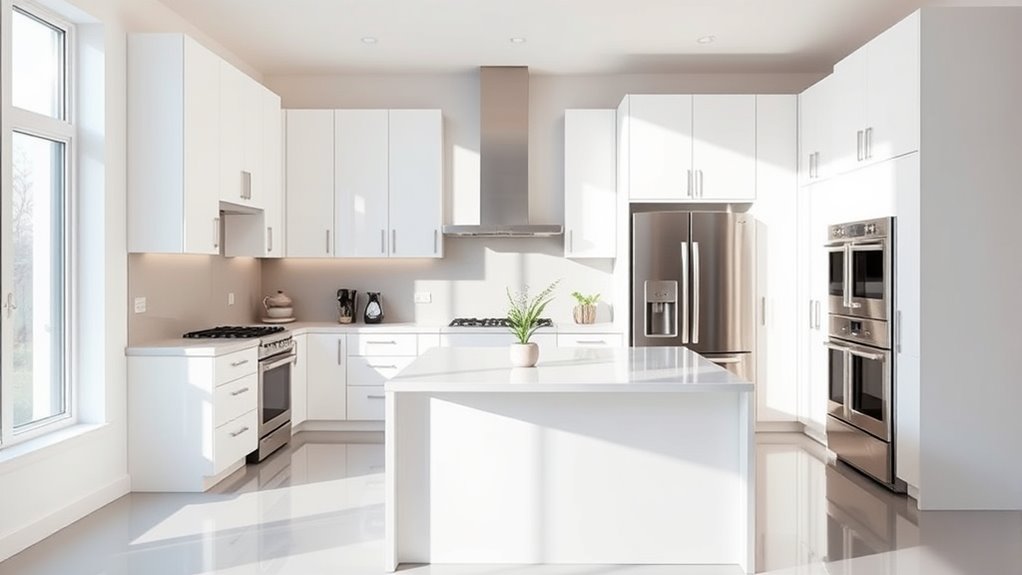
Creating a seamless look in your minimalist kitchen starts with choosing the right appliances. Opt for panel-ready options that blend effortlessly into your cabinetry, enhancing the overall aesthetic.
Smaller appliances, like compact refrigerators, not only reduce visual clutter but also encourage frequent shopping, keeping your kitchen feeling fresh. Consider induction cooktops that can be flush-mounted into countertops for a sleek, modern appearance and quick cooking response.
Conceal dishwashers and refrigerators behind cabinet doors to maintain uniformity and eliminate the disruption caused by standard designs.
Finally, implement flexible storage solutions, such as wide drawers and concealed shelves, to keep your appliances organized and accessible while preserving that minimalist vibe.
Incorporating innovative design solutions can further elevate the functionality and style of your kitchen. With stainless steel accents, your kitchen will look polished and cohesive.
Maintaining a Neutral Color Palette
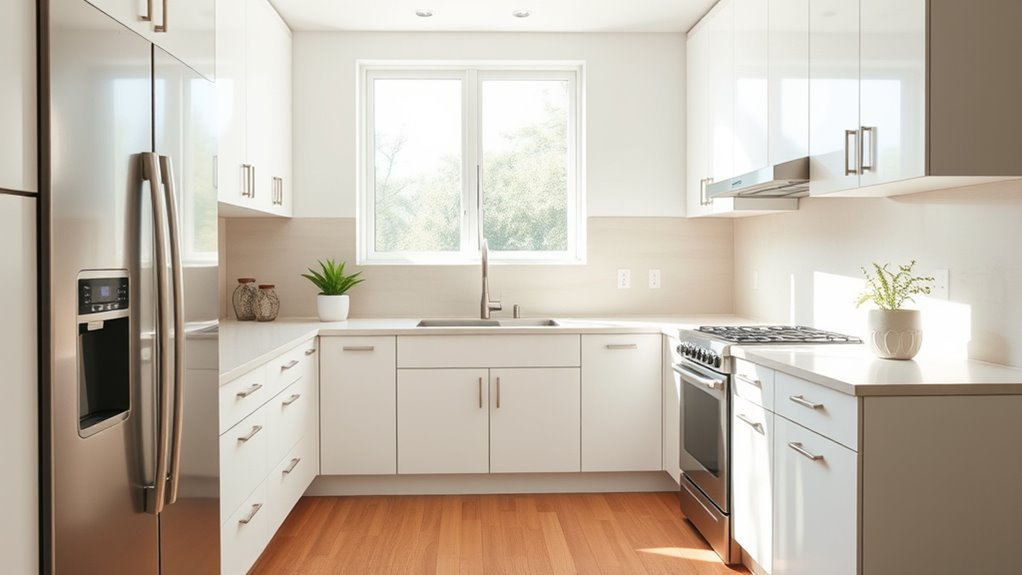
A neutral color palette is essential for achieving a serene and cohesive atmosphere in your minimalist kitchen. Incorporate shades of whites, grays, and soft earth tones to create a calming environment.
While maintaining this palette, add depth through textures with materials like wood, stone, and metal in neutral tones. Guarantee cabinetry, countertops, and backsplashes share a consistent color scheme to enhance spaciousness and keep the look uncluttered.
You can introduce bright accents sparingly with accessories, but remember that the foundation should remain neutral to preserve the minimalist aesthetic.
When selecting paint or finishes, choose high-quality, durable materials that’ll stand the test of time, guaranteeing your kitchen remains timeless while you’re creating a minimalist space you love.
Regularly Editing Your Kitchen Items
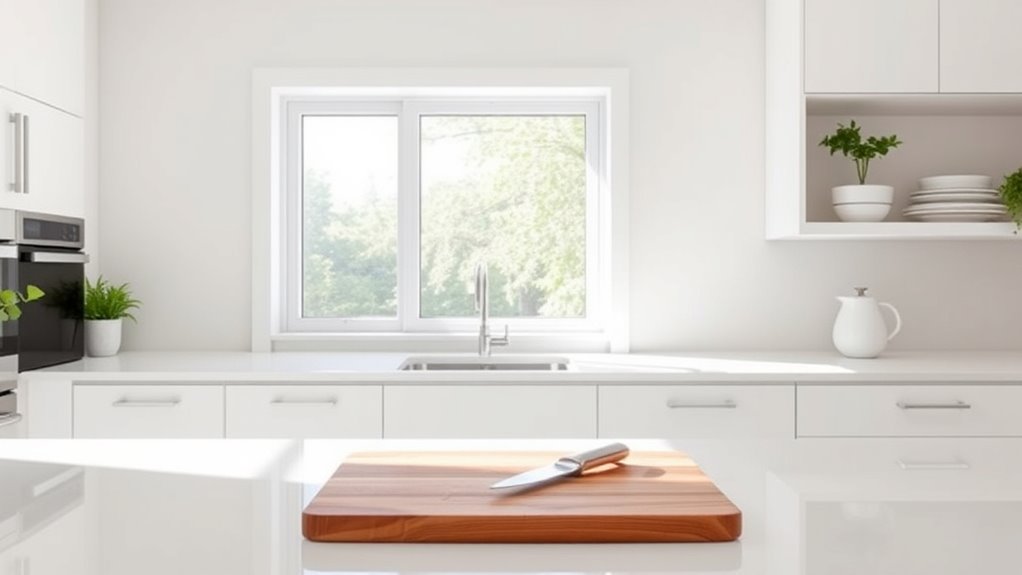
Regularly editing your kitchen items is key to maintaining a clutter-free and functional space. Start by evaluating what you’ve used in the past year; eliminate any unnecessary tools or appliances.
Follow a rule of thumb: keep only those dishes and utensils used within the last six months. This helps create a minimalist environment. Limit your cooking equipment to versatile options, retaining just a couple of high-quality utensils like wooden spoons and spatulas, along with a single colander.
Conduct monthly checks of your pantry and refrigerator to discard expired items, reinforcing organized storage. Consider packing away non-essential items that are infrequently used. This streamlines your kitchen setup and promotes a more intentional approach to your belongings. Embracing minimalist environments can further enhance your kitchen’s tranquility and functionality.
Creating a Serene Cooking Environment
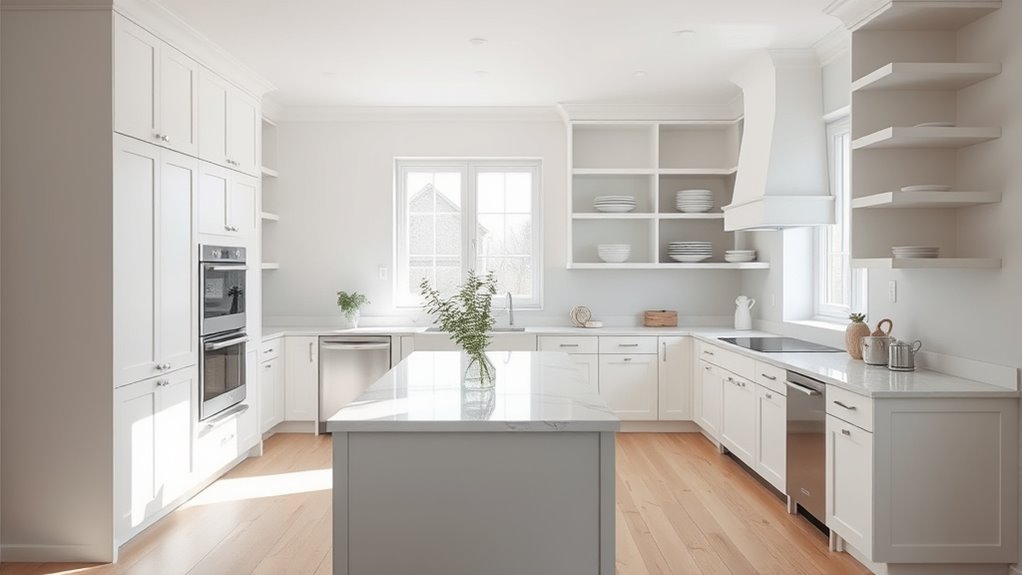
Maintaining a clutter-free kitchen paves the way for a serene cooking environment where you can focus and enjoy the process.
When creating a minimalist kitchen, prioritize clean lines and open shelving for everyday essentials, making items easily accessible while minimizing dust accumulation. Opt for high-quality materials and appliances that enhance both the aesthetic and functionality of your space, ensuring a lasting and enjoyable cooking experience. Establish a designated landing strip for temporary items to prevent clutter buildup and foster a sense of calm. Regularly declutter and evaluate your tools based on usage frequency, removing distractions that disrupt your peace. Incorporating lighting design can also significantly enhance the ambiance, making your kitchen not only functional but also inviting.
Frequently Asked Questions
How to Keep a Minimalist Kitchen?
To keep a minimalist kitchen, you need to regularly assess and declutter your items, only keeping what you’ve used in the past year.
Implement monthly checks of your pantry and refrigerator to reduce waste and improve accessibility.
Limit what’s on your countertops to daily essentials, and regularly evaluate their necessity.
Use storage solutions like clear containers for visibility and maintain a weekly cleaning routine to foster a tidy, organized space.
How Many Dishes Should a Minimalist Have?
Think of your kitchen as a serene pond; too many ripples create chaos.
For a minimalist, 6-8 dinner plates and matching salad plates hold the balance for daily meals and guests. Each family member deserves two versatile bowls, simplifying meal prep.
Instead of clutter, issue water bottles to cut down on extra cups. Limit your dishware to what you’ve used in the last six months, focusing on quality that enhances your kitchen’s calm aesthetic.
How to Build a Timeless Kitchen?
To build a timeless kitchen, focus on high-quality materials like solid wood and natural stone that withstand trends.
Stick to a neutral color palette, adding a pop of color where it feels right.
Choose functional appliances and fixtures that enhance usability without cluttering your space.
Limit decorative elements, opting for classic designs instead.
Finally, use open shelving sparingly to showcase select items, ensuring your kitchen feels both airy and organized for years to come.
What Is the Most Efficient Type of Layout for a Kitchen Design?
Imagine a dance where each partner moves fluidly, never stepping on toes. That’s how the work triangle operates in your kitchen, connecting the stove, sink, and refrigerator for seamless efficiency.
If you’re tight on space, consider a galley layout, where two counters parallel each other, enhancing workflow.
Alternatively, an L-shaped kitchen offers flexibility and zones for cooking, prep, and dining, creating a harmonious space that invites both functionality and connection.
Conclusion
So there you have it—your blueprint for a minimalist kitchen that screams sophistication without the clutter. Picture yourself cooking in a sleek, white space, where every utensil has a designated spot and the only thing more organized than your cabinets is your social life. Embrace your inner Marie Kondo, and remember: less is more, unless we’re talking about snacks. In that case, go ahead and hoard those chips—just don’t let them ruin your kitchen’s zen vibe!

